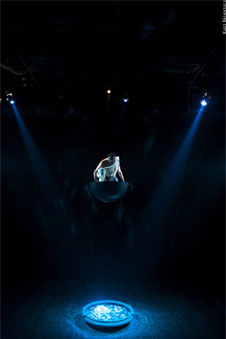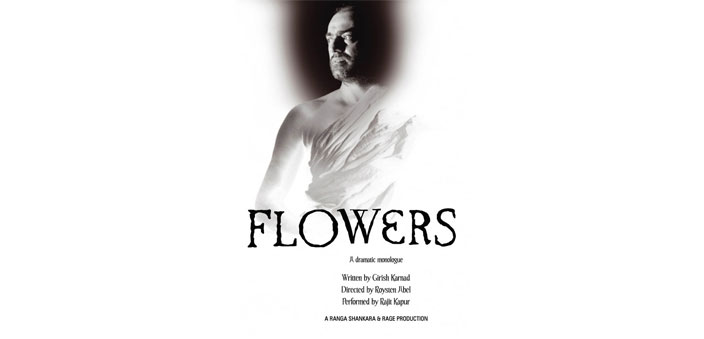UGirish Karnad is a consummate story teller and brilliant dramatist who likes to dig deep into Indian religious and socio-cultural reality to come up with thought-provoking plays like Yayati, Hayavadana, Tughlaq, etc. These plays have attracted limelight for all the right reasons. Unfortunately, his Flowers did not receive the same level of critical acclaim. Yet, Rage Productions, a Mumbai-based theatre group, has been mounting the shows of Flowers quite regularly. And thank God for this.
Flowers is unique
Flowers is a unique play for many reasons. One, it is a one-person show. Second, its set-design is quite unusual and eye-catching. Third, it has the most attention-catching, dramatic monologue, and fourth, the quality of acting is outstanding. Flowers narrates the story of a Brahmin priest from Chitradurga in Karnataka. Like his early plays such as Hayavadana and Nagmandala, this one too is based on a folk tale. The story revolves around a priest who is torn between his equal love for Lord Shiva, his wife, and his mistress, the wealthy and beautiful courtesan Chandravati. Karnad uses this folktale to communicate the inner turmoil of a pious man, and the power of sex and unsatiated desires. The protagonist of the play, the Brahmin priest could have been a Vaishnavaite, but Karnad makes him a Shaivaite so that he can use the motif of Lord Shiva’s lingam. The devout priest ends up violating both his dharma as well as his bhakti, thanks to his love for the courtesan Chandravati. Similarly, he is also torn between his duty to his king and his duty to his wife. In Flowers which is a one-person performance, the priest talks to the audience when these issues have already come to surface.
The plot
The priest is leading a quiet, uneventful life and is happy with the worship of the lingam. He describes to the audience his relationship with the lingam of the sanctum. He painstakingly decorates it every day, spending countless hours on this activity. This obsession of decorating the lingam brings him recognition, and his decoration is talked about in and around his village. This also makes the shrine a favourite of the village chief. The priest is a married man, and has been living with his children and old parents.
His life witnesses an earthquake of sorts when his temple is visited by the famous courtesan Chandravati. He is smitten by her beauty and sex appeal. He fights with himself for a while, but finally gives in to the demands of his body. One night he finds himself at her doors. Chandravati lets him in only on the condition that he would decorate her just like he decorates the lingam. As is natural, the priest initially hesitates, but soon begins to enjoy the process. This is because a woman’s body, that too body of a courtesan, offers many contours than the lingam. Thus begins a new routine in the priest’s life. He decorates the lingam with flowers at dawn and then with the same flowers he decorates Chandravati’s body at dusk.

As it happens often, such things don’t last. First to suspect is his wife and then the villagers. His wife is anguished because his reputation is in ruins now. Things are exposed when one day the priest is forced to perform pooja of the lingam with the flowers he has already used to decorate Chandravati. The village chief finds a long hair in his prasad and comments, ‘I did not know that God had long hair.’ This incident triggers a series of events in the life of the revered priest, his wife and others. These incidences lead to an array of conflicts for the priest. The priest is caught between the erogenous devotion for the lingam and an untiring love for the courtesan. To confuse matters further is his love for his legally wedded wife. The objects of his desire – the lingam and his love for the courtesan are worshipped by the same set of flowers every day.
In situations like this, there are no easy answers. One is weighed down by the guilt too.
The performance
With such a loaded script, director Roysten Able had a tough job on hand. But with competent cast like veteran Rajit Kapur, Able has created a masterpiece. He has designed the entire play so beautifully that the audience remains riveted throughout the performance, something quite rare for a one-person show.
When the audience enters the hall, they are greeted with the smoky fragrance of dhoop. This scene lasts for about one full minute during which the audience gets restless. Then Rajit Kapur starts his one-person performance, which is a 90- minute monologue in English. His performance is at the core of the show.
The show begins when the priest stands up, turns around to face the audience, and begins to talk. Though the setting is a temple, the priest is standing above the temple tank. As has been mentioned above, the priest has been worshipping the lingam, decorating it every day with fresh flowers. He is so devoted to the lingam that he even speaks with it, discusses contemporary politics with it.
The set consists of an elevated platform, so that the solitary character seated on it, appears suspended in the air. This suspension assumes a special meaning as the play progresses. With the priest on this elevated platform, on a stage scattered with tiny white jasmines, is an urli decorated with flower garlands. Then in the background the audience gets to see a heap of jasmine flowers sloping gently over the lingam. The light design (Arghya Lahiri) and the sound design (Amit Heri) are simply wonderful, and most apt for the play.
I have only a couple of things to cavil about. The end part of the monologue, should be edited. It drags. And the other is about the language. Since the entire ambience of the play is Indian, had it been written in Hindi, it would have left a far deeper impact than what it does in English. Words like lingam and dhoop would have been better received in Hindi.


 [/column]
[/column]